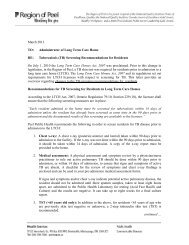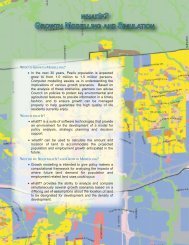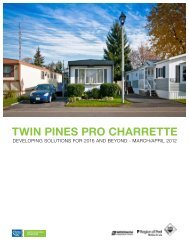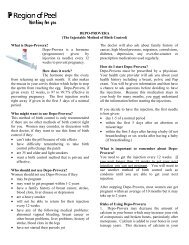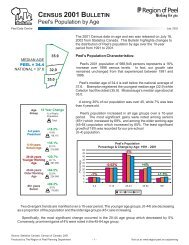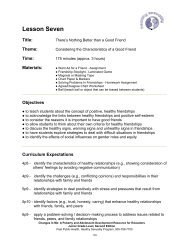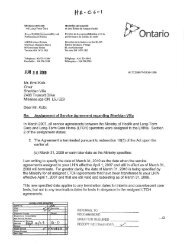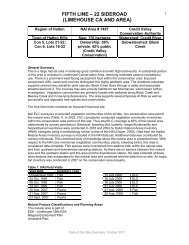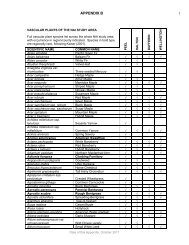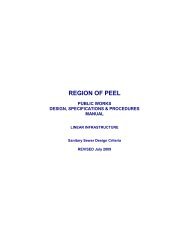Ecological Footprint - Region of Peel
Ecological Footprint - Region of Peel
Ecological Footprint - Region of Peel
You also want an ePaper? Increase the reach of your titles
YUMPU automatically turns print PDFs into web optimized ePapers that Google loves.
<strong>Ecological</strong> <strong>Footprint</strong><br />
The Average <strong>Peel</strong> Resident's<br />
<strong>Ecological</strong> <strong>Footprint</strong> by<br />
Land/Area Category (%)<br />
This diagram illustrates the average ecological footprint or total<br />
land and water area that is required to support a resident <strong>of</strong><br />
<strong>Peel</strong> <strong>Region</strong> by land and water category.<br />
Pasture Land<br />
3%<br />
Built Land<br />
4%<br />
Sea Space<br />
2%<br />
CD: Census Division<br />
CMA: Census Metropolitian<br />
Area<br />
ECOLOGICAL FOOTPRINTS<br />
Comparing <strong>Footprint</strong>s in the Greater Toronto Area<br />
Canada<br />
Toronto (CMA)<br />
York <strong>Region</strong>al<br />
Municipality<br />
(CD)<br />
<strong>Peel</strong> <strong>Region</strong>al<br />
Municipality<br />
(CD)<br />
September 2004<br />
Halton<br />
<strong>Region</strong>al<br />
Municipality<br />
(CD)<br />
Hamilton<br />
(CMA)<br />
Energy Land 4.00 4.05 4.56 4.23 5.03 4.03<br />
Crop Land 1.39 1.48 1.70 1.70 1.70 1.50<br />
Pasture Land 0.21 0.22 0.25 0.25 0.25 0.23<br />
Sea Space 0.15 0.15 0.18 0.18 0.18 0.22<br />
Forest Land 1.14 1.14 1.27 1.16 1.43 1.09<br />
Built Area 0.36 0.31 0.32 0.31 0.32 0.31<br />
Forest Land<br />
17%<br />
Total <strong>Ecological</strong><br />
<strong>Footprint</strong> (hectares per<br />
capita)<br />
7.25 7.35 8.28 7.83 8.91 7.37<br />
Crop Land<br />
21%<br />
Comparing the <strong>Ecological</strong><br />
<strong>Footprint</strong> Internationally<br />
How Does Canada Compare? The FCM report found that the<br />
average Canadian has the third largest ecological footprint in<br />
the world, behind the United States and the United Arab<br />
Emirates. Current analysis shows that on average the<br />
Canadian ecological footprint is 7.25 hectares. This indicates<br />
that it takes 7.25 hectares <strong>of</strong> land and sea throughout the<br />
world to support each Canadian.<br />
Internationally, ecological footprints in many other countries<br />
are much lower than Canada's as indicated by the following<br />
examples:<br />
• India - 0.86 hectares/person<br />
• Pakistan - 0.64 hectares/person<br />
• Japan - 4.77 hectares/person<br />
Source: WWF Living Planet Report 2002<br />
Energy Land<br />
53%<br />
INFORMATION NEEDED TO CALCULATE AN ECOLGICAL FOOTPRINT<br />
HOUSEHOLD OR<br />
INDIVIDUAL<br />
FOOTPRINT<br />
CITY, TOWN<br />
OR REGION<br />
FOOTPRINT<br />
What can I do to change my<br />
community's and my personal<br />
footprint?<br />
While it may not be possible to affect all <strong>of</strong> the variables that<br />
produce your community's ecological footprint, you can<br />
personally take action in several ways to reduce your<br />
individual ecological footprint.<br />
If enough individual action is taken we can expect to observe<br />
improvements in the <strong>Region</strong>'s ecological footprint over time.<br />
You may wish to try some <strong>of</strong> the following actions in these<br />
areas:<br />
Food:<br />
• Buy more locally grown and organic food<br />
• Buy more unpackaged and unprocessed foods<br />
• Eat vegetarian meals more frequently<br />
Mobility:<br />
• Drive your car less and carpool whenever possible<br />
• If you drive, choose a more fuel efficient vehicle<br />
• Use public transit, bike or walk whenever possible<br />
Housing:<br />
• Hang clothes to dry - limit the number <strong>of</strong> loads <strong>of</strong> laundry<br />
_ that go in your dryer<br />
• Reduce the number <strong>of</strong> days you use the air conditioner<br />
Practice water and energy conservation<br />
• Turn <strong>of</strong>f lights and use energy efficient bulbs and appliances<br />
» Amount and type <strong>of</strong> food consumed<br />
» Amount and type <strong>of</strong> electricity used<br />
» Size <strong>of</strong> house or apartment<br />
» Gasoline use<br />
» Population density<br />
» Average household size<br />
» Consumer spending<br />
» Energy use<br />
Try these simple suggestions and see how much you can<br />
reduce your ecological footprint.<br />
» Fuel efficiency<br />
» Miles travelled by vehicle, transit, bike<br />
and foot<br />
» Urban land use<br />
Produced by The <strong>Region</strong> <strong>of</strong> <strong>Peel</strong> Planning department<br />
- 2 -<br />
Note: All Charts and Graphs are reproduced from the <strong>Ecological</strong> <strong>Footprint</strong>s <strong>of</strong><br />
Canadian Municipalities and <strong>Region</strong>s report prepared by Anielski<br />
Management Inc. for the Federation <strong>of</strong> Canadian Municipalities.<br />
Visit us at: www.peelregion.ca/planning



